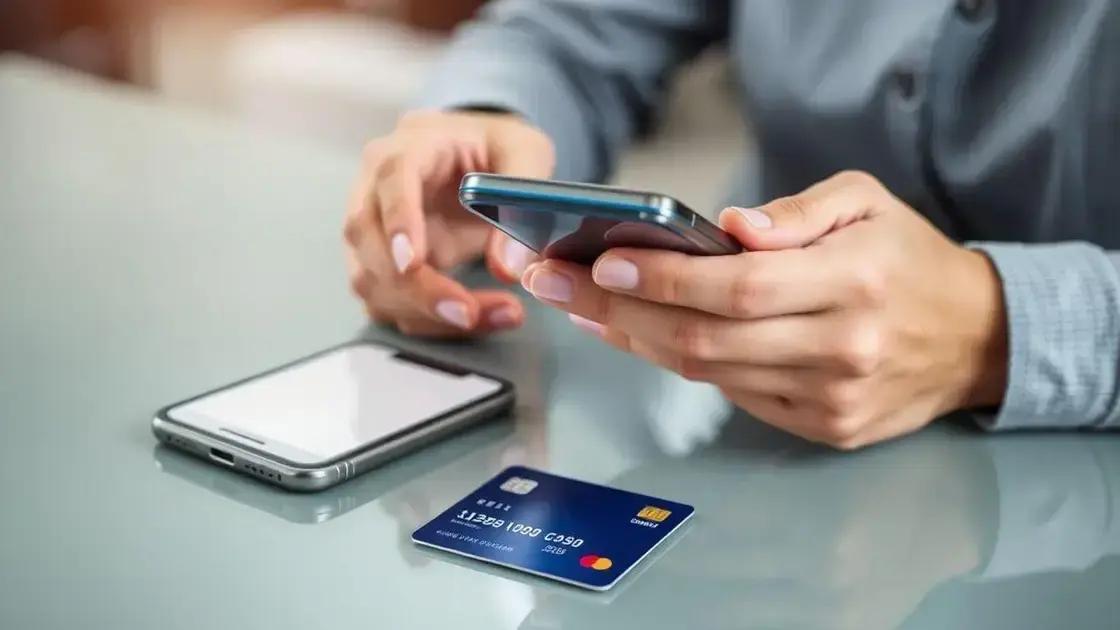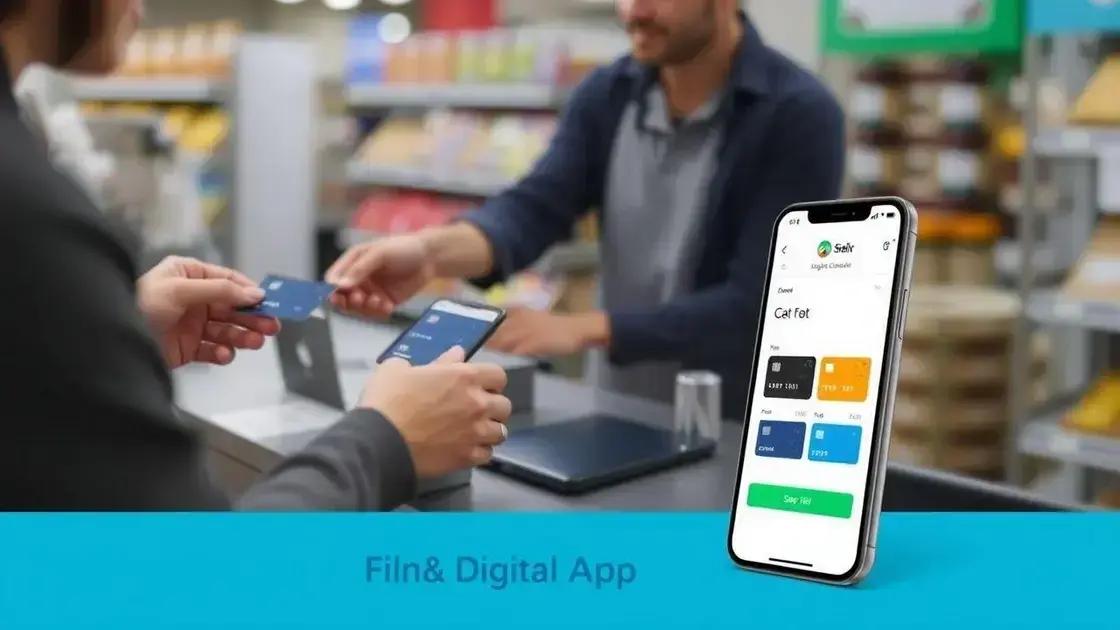Latest updates on credit card and digital wallet integration

The latest updates on credit card and digital wallet integration emphasize enhanced security, faster transactions, and the increasing use of AI and blockchain technology to streamline payment processes and improve user experience.
Latest updates on credit card and digital wallet integration show how these technologies are reshaping our shopping experiences. With more retailers embracing digital solutions, aren’t you curious about the advantages and challenges they’re bringing along?
Understanding credit card integration
Understanding credit card integration is essential for businesses that want to streamline their payment processes. This integration enables businesses to accept payments directly through their websites or apps, making it easier for customers to complete transactions. As digital transactions grow, knowing how this integration works is vital.
What is Credit Card Integration?
Credit card integration involves connecting a payment gateway to a business’s website or software system. This process allows the merchant to securely receive card payments without extensive manual work. Customers can feel safe entering their information, and businesses can manage transactions more efficiently.
Benefits of Credit Card Integration
- Improved transaction speed and efficiency.
- Enhanced security for customer payment information.
- Access to valuable transaction data for better decision-making.
- Attracting more customers who prefer online payments.
When businesses implement credit card integration, they often see faster cash flow. This efficiency is crucial, especially for small businesses looking to grow. Plus, integrating payment solutions helps in reducing the chances of human error during transactions.
Another significant aspect of credit card integration is its scalability. As businesses grow, their payment processing needs may change. Integration options allow for easy upgrades or adjustments based on customer demand. The flexibility of adapting to new technologies plays a pivotal role in staying competitive.
Challenges of Credit Card Integration
Despite the benefits, there can be challenges with credit card integration. Technical issues can arise, leading to temporary disruptions in service. Additionally, understanding compliance with payment card industry standards is crucial to protect sensitive information.
For many businesses, the initial setup may involve costs, which can be a hurdle. However, the long-term benefits of seamless transactions and improved customer satisfaction often outweigh these initial investments. It’s important for businesses to weigh the pros and cons carefully.
In summary, credit card integration is an integral part of modern commerce. With advancements in technology, understanding this topic can empower businesses to take advantage of opportunities in today’s fast-paced market.
The rise of digital wallets
The rise of digital wallets is changing the way we handle our finances. These convenient tools allow users to store credit card information and make payments through their smartphones. As technology progresses, it’s essential to understand how digital wallets are becoming a staple in everyday transactions.
What are Digital Wallets?
Digital wallets are applications or software that let users keep their payment information in one secure location. Users can link their credit cards, debit cards, and bank accounts to make quick and hassle-free payments. Just a few taps on a smartphone can complete a purchase, saving time for both consumers and merchants.
Benefits of Using Digital Wallets
- Enhanced security features to protect user data.
- Faster transactions, reducing waiting time at checkout.
- Integration with rewards programs for savings and benefits.
- Convenience of not carrying physical cards.
Many people are opting for digital wallets due to their user-friendly nature. The ability to check out quickly without fumbling for cash or cards makes shopping more efficient. Moreover, most digital wallets offer features like transaction history, enabling users to track their spending easily.
As we embrace digital innovations, these wallets allow users to pay for items directly from their smartphones. The integration of this technology into everyday life is fast becoming the norm. Retailers and service providers are also catching on, with many implementing digital wallet acceptance to meet consumer demand.
Challenges to Overcome
Despite their benefits, digital wallets may present challenges. Users must ensure they have a secure Internet connection to avoid data breaches. Since digital wallets rely on technology, technical glitches can hinder transactions. Additionally, some consumers may still feel hesitant about using digital systems over traditional cash or cards.
Regardless of these challenges, the rise of digital wallets is undeniable. They are paving the way for a cashless future and reshaping how we interact with money on a regular basis. With their rapid adoption, staying informed about their workings is important for anyone looking to simplify their financial transactions.
Benefits of combining cards and wallets

The benefits of combining cards and wallets are becoming evident as more people seek convenience in their payment methods. Merging traditional credit cards with digital wallets offers a streamlined experience, enabling users to enjoy the best of both worlds.
Enhanced User Experience
One of the primary benefits is the enhanced user experience. By combining cards with digital wallets, users can pay quickly without reaching for their physical cards. This saves time and makes transactions smoother at checkout. Imagine just tapping your phone to pay, rather than fumbling with cards or cash.
Increased Security
Combining cards with digital wallets also enhances security. Unlike traditional cards that can be lost or stolen, digital wallets often include advanced encryption techniques, protecting sensitive information. Users can also set up biometric authentication, adding another layer of security. This peace of mind is a significant draw for many consumers.
- Authentication methods such as fingerprints or facial recognition.
- Instant alerts for transactions to monitor activity.
- Ability to suspend or cancel digital wallet access quickly.
Moreover, the integration allows users to organize their payment methods effectively. With one digital wallet app, users can access multiple cards, making it easy to choose how to pay based on rewards or promotions. This flexibility helps consumers leverage their financial resources better.
Combining cards with digital wallets can lead to financial rewards as well. Many wallets offer cashback or points for transactions, providing users additional value for their spending. By uniting these tools, consumers have the chance to earn rewards more efficiently.
Streamlined Spending Tracking
Another considerable advantage is the ability to track spending seamlessly. Users can view their transactions in real time through their digital wallet app. This helps in budgeting and understanding spending habits more effectively. Such visibility supports better financial decisions, ensuring users stay within their budgets.
As consumers embrace a more cashless lifestyle, exploring the benefits of combining cards and digital wallets becomes essential. It enables smoother transactions, enhanced security, and improved financial management—all critical factors for today’s savvy shoppers.
Security concerns in digital payments
Security concerns in digital payments have become more significant as the usage of technology in transactions increases. Users desire the ease of digital payments, but it’s essential to be aware of the risks involved.
Common Threats to Digital Payments
One of the main security concerns is the risk of data breaches. Cybercriminals are constantly searching for ways to access sensitive information. This includes credit card numbers and personal data. Users must stay alert to protect themselves against identity theft, which can result from compromised payment information.
Encryption and Security Measures
To combat these threats, many digital payment providers implement encryption and secure protocols. These technologies help protect user data during transactions, making it difficult for hackers to intercept information. Using secure connections, such as HTTPS, also ensures that data transmitted between users and merchants is safeguarded.
- Two-factor authentication adds an extra layer of security.
- Regular software updates protect against vulnerabilities.
- Monitoring for suspicious activities helps prevent fraud.
Moreover, many digital wallet services offer features that alert users to any unusual activity. This allows for immediate action if unauthorized transactions are detected, providing an added sense of safety. Combining these security measures can significantly reduce the risk associated with digital payments.
However, users must also take proactive steps. Keeping devices updated and using strong, unique passwords plays a crucial role in ensuring security. Educating themselves on phishing scams can prevent users from unintentionally providing sensitive information to malicious actors.
The Importance of User Responsibility
Ultimately, while digital payment systems are designed with security in mind, users must remain vigilant. By being aware of potential risks and practicing safe online behaviors, they can better protect their financial information. Increasing awareness and, understanding security concerns in digital payments are vital for a safe and smooth transaction experience.
Future trends in payment technologies
The future trends in payment technologies are exciting and constantly evolving. As technology advances, consumers and businesses will continue to see new methods of making transactions easier and more secure.
Rise of Contactless Payments
One major trend is the rise of contactless payments. Technologies like NFC (Near Field Communication) allow users to pay simply by tapping their smartphone or card on a terminal. This method speeds up transactions, making checkouts quicker and more efficient.
Integration of AI and Machine Learning
Another significant advancement is the integration of AI and machine learning in payment systems. These technologies can enhance fraud detection and improve customer service. By analyzing transaction patterns, AI helps identify suspicious behavior in real-time. This proactive approach makes spending safer for users.
- AI-driven chatbots assist with payment inquiries.
- Personalized shopping experiences tailored to user preferences.
- Smart notifications about spending habits and budget management.
Additionally, the emergence of blockchain technology is reshaping the payments landscape. It offers enhanced security and transparency for transactions. With blockchain, users can have more control over their financial data while ensuring fast and low-cost transfers.
Furthermore, the demand for cryptocurrencies is growing. More businesses are beginning to accept digital currencies like Bitcoin as a payment option. This trend represents a shift in how people will view and use money in the future.
Focus on Enhanced Security
As payment technologies develop, there will be a growing focus on user security. Enhanced biometric authentication methods, such as facial recognition and fingerprint scanning, are gaining popularity. These methods add layers of protection to payment processes, ensuring that only authorized users can access accounts.
Overall, the future of payment technologies looks bright. With advancements in contactless payments, AI, blockchain, and enhanced security, the way we conduct transactions will continue to evolve. Staying informed about these trends will help consumers and businesses adapt to tomorrow’s financial landscape.
FAQ – Frequently Asked Questions about Payment Technologies
What are some benefits of contactless payments?
Contactless payments allow for faster transactions, reducing the time spent at checkout, and provide convenience without needing to swipe or insert a card.
How does AI improve payment security?
AI enhances payment security by analyzing transaction patterns to detect fraudulent activities in real time, helping to protect users from potential threats.
What role does blockchain play in digital payments?
Blockchain technology increases security and transparency by providing a decentralized ledger that records all transactions securely and immutably.
Why is enhanced security important in digital payments?
Enhanced security measures, such as biometric authentication, are crucial to protect sensitive financial information from unauthorized access and fraud.






